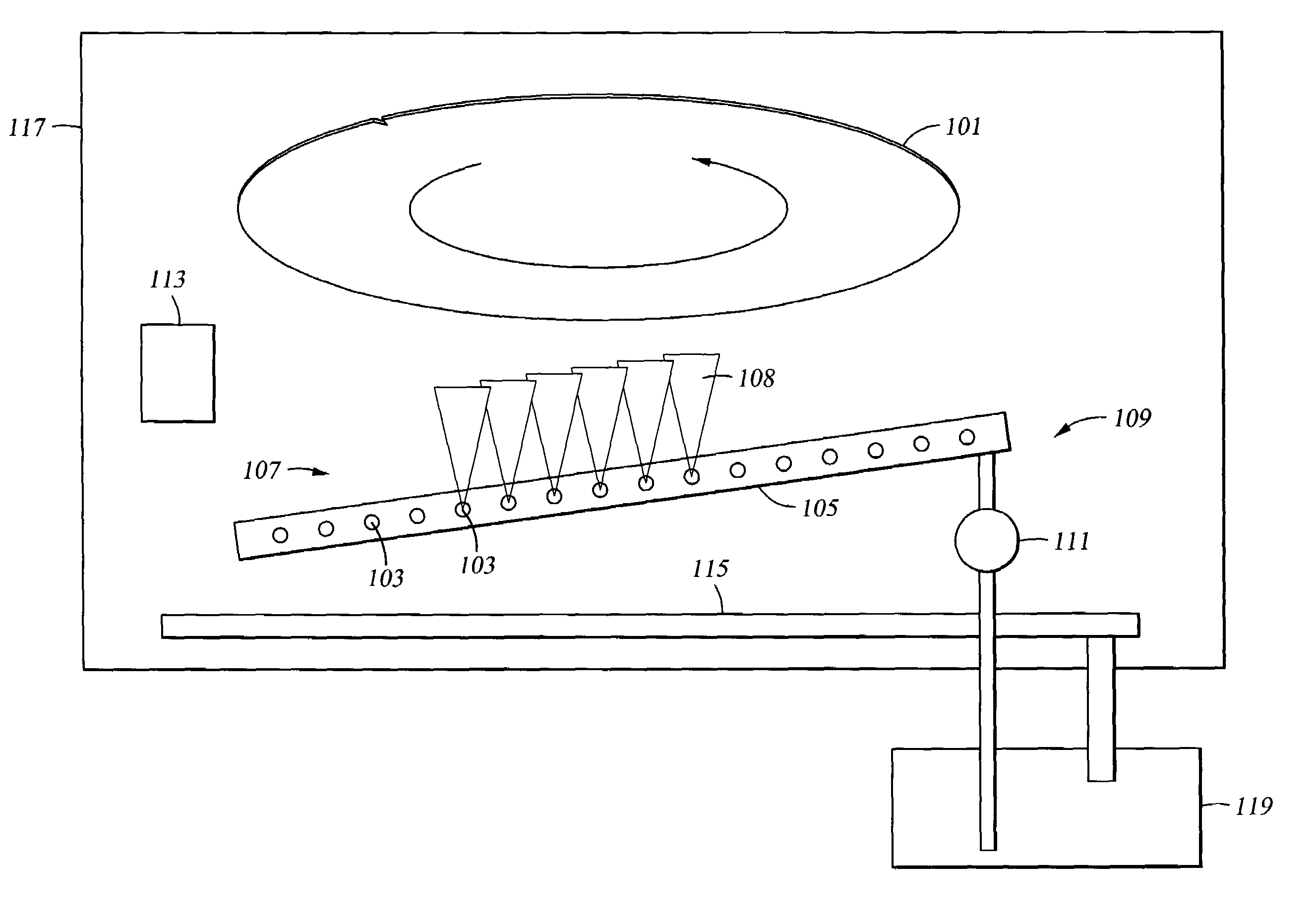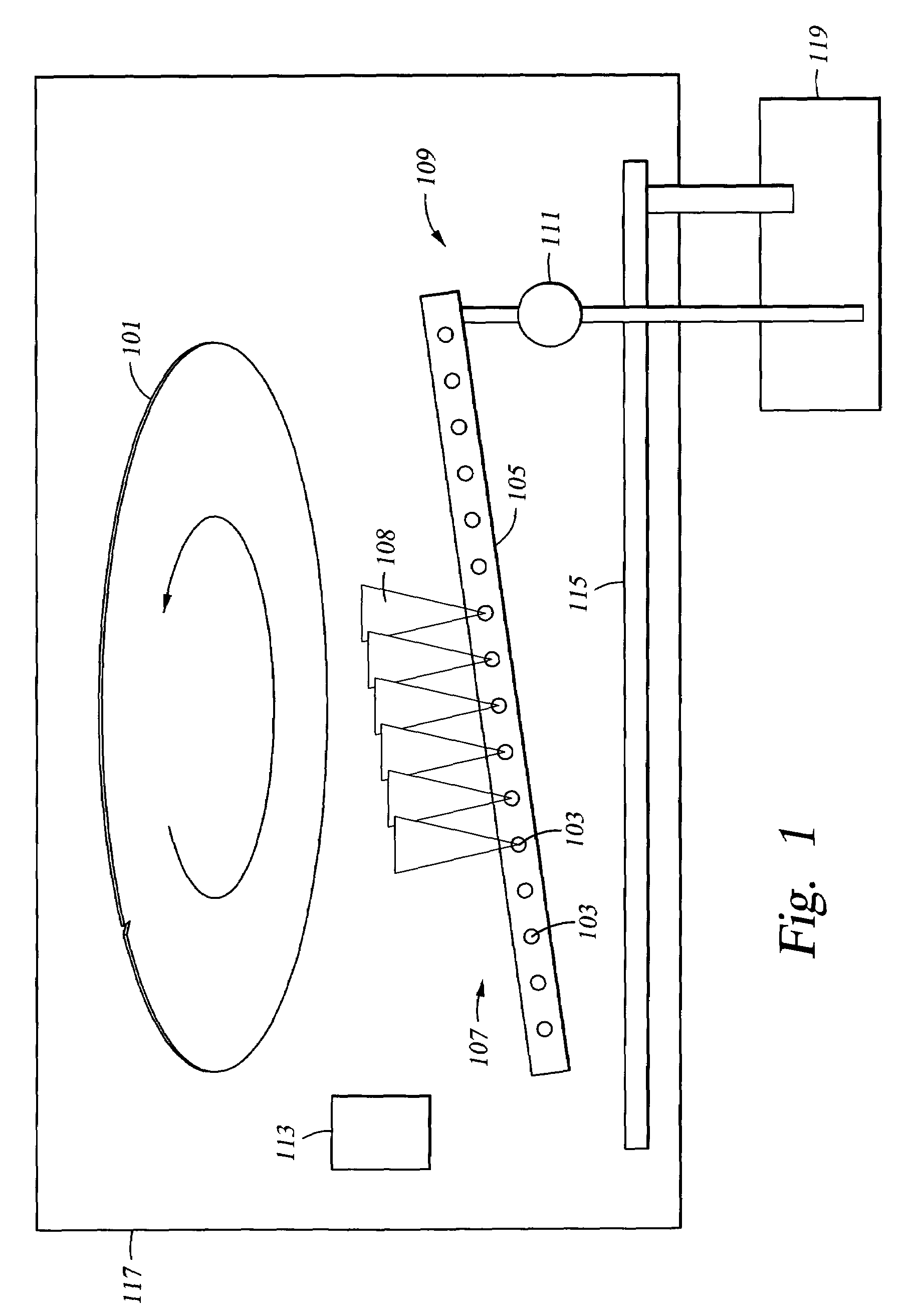Method for chemical-mechanical jet etching of semiconductor structures
a technology of chemical mechanical jet etching and semiconductor structure, which is applied in the direction of spray nozzles, basic electric elements, decorative arts, etc., can solve the problems that the etch rate achievable by such methods is generally too low to be practical in commercial production, and achieves rapid and accurate removal of large amounts of material, high etching efficiency, and high etching efficiency.
- Summary
- Abstract
- Description
- Claims
- Application Information
AI Technical Summary
Benefits of technology
Problems solved by technology
Method used
Image
Examples
example 1
[0021]In a first embodiment of the invention, a silicon wafer, other semiconductor substrate, or other workpiece, is uniformly thinned by using the apparatus shown in FIG. 1.
[0022]A workpiece (not shown) is affixed to the workpiece holder 101, and the holder 101 rotates the workpiece beneath the injector bar 105, with its array 107 of high-pressure nozzles 103. A machining etchant, in the form of a slurry or suspension of appropriate particulate material in a chemical etchant / solvent, in a concentration in the range of from about zero to about 95 weight percent, is pumped by pump 111 through delivery system 109 to nozzle array 107 on injector bar 105, at a nozzle pressure in the range of about 7 to about 70 Kg / cm2. Nozzles 103 then deliver the machining etchant 108 as a high-pressure jet which impinges upon the workpiece wafer as the holder 101 and workpiece rotate past the nozzles 103 at a speed ranging from about 100 to about 2000 RPM.
[0023]The angle at which the machining...
example 2
Patterning
[0028]A second embodiment of the invention uses the same the general apparatus as is illustrated by FIG. 1, and operation as described in Example 1, but utilizes a patterned mask applied to the surface of the semiconductor workpiece to permit selective etching of a surface of that workpiece. Relatively large-scale features, such as trenches and vias with critical dimensions in the range of from about 5 to several hundred microns, and depths of up to the full thickness of the workpiece wafer, can be readily produced in this way, again at etch rates as high as about 100 microns of depth per minute. Typical process conditions for this embodiment of the method of the invention are also as presented in Table I, above.
[0029]The patterned mask may consist of either a conventional organic photoresist, or a glasslike silane material, or an inorganic hard mask, such as silicon oxide or silicon nitride, which are generally known in the art.
[0030]This chemical-mechanical jet etch meth...
example 3
Maskless Jet Etching.
[0033]A third embodiment of the invention again uses the basic apparatus illustrated in FIG. 1, but, as in the wafer thinning operations described in Example 1, uses no mask. Instead, in this embodiment, intended for making multiple vias in or through a silicon wafer or other semiconductor workpiece, the workpiece is held stationary, and a narrow stream of machining etchant is directed, from a single narrowly-focused nozzle, at each desired via location, serially with one nozzle or concurrently with multiple nozzles, until the desired etch depth is achieved. Pulsed delivery of machining etchant, as described above, may be advantageous to avoid buildup of machining etchant loaded with etched material, or stagnation of the etchant, in the hole. Process conditions are again generally those shown in Table 1. Features in the size range of about 10 μ or larger can be direct-written in this way.
[0034]The narrowly-focused machining etchant stream of this embodiment may ...
PUM
| Property | Measurement | Unit |
|---|---|---|
| thickness | aaaaa | aaaaa |
| diameter | aaaaa | aaaaa |
| thickness | aaaaa | aaaaa |
Abstract
Description
Claims
Application Information
 Login to View More
Login to View More - R&D
- Intellectual Property
- Life Sciences
- Materials
- Tech Scout
- Unparalleled Data Quality
- Higher Quality Content
- 60% Fewer Hallucinations
Browse by: Latest US Patents, China's latest patents, Technical Efficacy Thesaurus, Application Domain, Technology Topic, Popular Technical Reports.
© 2025 PatSnap. All rights reserved.Legal|Privacy policy|Modern Slavery Act Transparency Statement|Sitemap|About US| Contact US: help@patsnap.com



